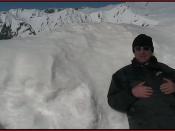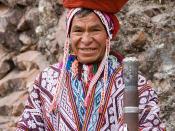Paper pretty but I'd do some more research most of my paper is quotes -
"Some ten to twenty-five million people (that is less than 1% of the earth's population) currently make it[high altitude zones] their home(Moran,143)." The adjustment high altitude populations must make are firstly physical and secondly cultural. Although most people adapt culturally to their surroundings, in a high altitude environment these cultural changes alone aren't enough. Many physical adaptations that reflect "the genetic plasticity common to all of mankind(Molinar,219)" have to be made to survive and even more than that thrive in this type of environment.
In this paper I will describe the high altitude stresses. Along with adaptations made by the populations living in them. The two high altitude populations which I will examine in this paper are the Tibetan people of the Asian Himalayas and the Quechua of the South American Andes.
The Quechua are an Indian people who inhabit the highlands of Peru and Bolivia.
They speak Quechua, which is a branch of the Andean-Equitorial stock. They show many remnants of Inca heritage by their houses, music, and religion which has pagan rites under the Roman-Catholic surface. Their villages consist of kin groups . Their marriage partners are taken from within each village. Agriculture is the dominant subsistence pattern in the central Andean region but the Nunoa region where the Quechua reside can only support a few frost-resistant crops. Which include bitter potato, sweet potato, and a few grain crops of quinoa and canihua. The rest of the fruits and vegetables of the Quechua come from the eastern mountains on it's way to the markets. The most important subsistence pattern for the Quechua is stock raising. Which is limited to the few animals that do well in the high altitudes. Their stock include...


